No edit summary |
|||
| Line 5: | Line 5: | ||
==Introduction== | ==Introduction== | ||
[[Image:Arcata-60ft clarifier.jpg|thumb|400px|left| | [[Image:Arcata-60ft clarifier.jpg|thumb|400px|left|Figure 1. The 60ft diameter primary clarifier tank at the Arcata plant.]] | ||
After passing through the [http://www.appropedia.org/Arcata_Marsh_headworks Headworks] where large solids, objects and particles are removed, the wastewater moves on to the primary clarifiers. Primary clarifiers, also known as sedimentation tanks, are used in wastewater treatment plants to remove solid materials from the water being processed. The [http://www.appropedia.org/Arcata_marsh#Arcata.27s_Wastewater_Plant Arcata Wastewater Treatment Plant] uses two clarifiers, one 26ft diameter tank and one 60ft diameter tank [http://www.appropedia.org/Image:Arcata-60ft_clarifier.jpg Figure 1]. | |||
<br clear="all" /> | <br clear="all" /> | ||
| Line 13: | Line 13: | ||
==Description== | ==Description== | ||
[[Image:Arcata - Skimmer.jpg|thumb|400px|right| | [[Image:Arcata - Skimmer.jpg|thumb|400px|right|Figure 2. The surface skimmer in the 60ft tank.]] | ||
[[Image:Clarifier_Drawing_(800pix).gif|thumb|400px|right|[Figure 3] Cross-sectional diagram of a primary clarifier.]] | [[Image:Clarifier_Drawing_(800pix).gif|thumb|400px|right|[http://www.gc3.com/techdb/manual/clartext.htm Figure 3.] Cross-sectional diagram of a primary clarifier.]] | ||
Wastewater enters the clarifier through the influent well [http://www.appropedia.org/Image:Clarifier_Drawing_%28800pix%29.gif Figure 3] in the center of the tank. Once the water enters the tank solids begin to settle out of the water; the denser solids(sludge) settle to the bottom of the tank and less dense solids(scum) and oils float to the surface. The floating scum is skimmed off of the surface by a large rotating arm called the surface skimmer [http://www.appropedia.org/Image:Arcata_-_Skimmer.jpg Figure 2]. Once collected by the surface skimmer the scum is deposited into the scum trough and is transported to a storage container alongside the clarifier [http://www.appropedia.org/Image:Dumpster_%28600pix%29.jpg Figure 4]. The sludge on the bottom of the tank gets collected by rotating collector arms which moves the sludge to the center of the tank. Once the sludge collects at the bottom of the tank it gets pumped to the [http://www.appropedia.org/Arcata_marsh_digester digester] to be processed and converted into [http://www.appropedia.org/Biogas biogas]. | |||
[[Image:Dumpster (600pix).jpg|thumb|200px|left|Figure 4. Floating solids and oils are deposited into this dumpster after being skimmed off of the surface.]]<br /> | |||
[[Image:Dumpster (600pix).jpg|thumb|200px|left| | |||
MORE TEXT WILL GO HERE | MORE TEXT WILL GO HERE | ||
| Line 30: | Line 29: | ||
==References== | ==References== | ||
*Davis, Mackenzie, and Susan Masten. Principles of Environmental Engineering and Science. McGraw Hill: New York, NY 2004. | *Davis, Mackenzie, and Susan Masten. Principles of Environmental Engineering and Science. McGraw Hill: New York, NY 2004. | ||
*[http://en.wikipedia.org/wiki/Sewage_treatment#Sedimentation http://www.en.wikipedia.org/wiki/Sewage_treatment#Sedimentation] | |||
*[http://www.gc3.com/techdb/manual/clartext.htm http://www.gc3.com/techdb/manual/clartext.htm] | |||
*[http://www.humboldt.edu/~ere_dept/marsh/flow2.html http://www.humboldt.edu/~ere_dept/marsh/flow2.html] | *[http://www.humboldt.edu/~ere_dept/marsh/flow2.html http://www.humboldt.edu/~ere_dept/marsh/flow2.html] | ||
*[http://www.humboldt.edu/~ere_dept/marsh/specs.html http://www.humboldt.edu/~ere_dept/marsh/specs.html] | *[http://www.humboldt.edu/~ere_dept/marsh/specs.html http://www.humboldt.edu/~ere_dept/marsh/specs.html] | ||
*[http:// | *[http://www.google.com/search?q=cache:imfHcSlgo14J:www.nmenv.state.nm.us/swqb/FOS/Training/WSOC_Study_Guide/NM_Water_System_Operator_Certification_Study_Guide.pdf http://www.nmenv.state.nm.us/swqb/FOS/Training/WSOC_Study_Guide/NM_Water_System_Operator_Certification_Study_Guide.pdf] | ||
*[http://209.85.173.104/search?q=cache:umgNlgFJLkQJ:www.ragsdaleassociates.com/PrimaryTreatment.doc http://www.ragsdaleassociates.com/PrimaryTreatment.doc] | *[http://209.85.173.104/search?q=cache:umgNlgFJLkQJ:www.ragsdaleassociates.com/PrimaryTreatment.doc http://www.ragsdaleassociates.com/PrimaryTreatment.doc] | ||
*[http:// | *[http://www.usace.army.mil/publications/armytm/tm5-814-3/chap11.pdf http://www.usace.army.mil/publications/armytm/tm5-814-3/chap11.pdf] | ||
*[http:// | *[http://water.me.vccs.edu/courses/newENV110/Lesson5_print.htm http://www.water.me.vccs.edu/courses/newENV110/Lesson5_print.htm] | ||
<references/> | <references/> | ||
*[] | |||
[[Category:Arcata marsh]] | [[Category:Arcata marsh]] | ||
Revision as of 02:50, 10 May 2008
Introduction

After passing through the Headworks where large solids, objects and particles are removed, the wastewater moves on to the primary clarifiers. Primary clarifiers, also known as sedimentation tanks, are used in wastewater treatment plants to remove solid materials from the water being processed. The Arcata Wastewater Treatment Plant uses two clarifiers, one 26ft diameter tank and one 60ft diameter tank Figure 1.
Description

Wastewater enters the clarifier through the influent well Figure 3 in the center of the tank. Once the water enters the tank solids begin to settle out of the water; the denser solids(sludge) settle to the bottom of the tank and less dense solids(scum) and oils float to the surface. The floating scum is skimmed off of the surface by a large rotating arm called the surface skimmer Figure 2. Once collected by the surface skimmer the scum is deposited into the scum trough and is transported to a storage container alongside the clarifier Figure 4. The sludge on the bottom of the tank gets collected by rotating collector arms which moves the sludge to the center of the tank. Once the sludge collects at the bottom of the tank it gets pumped to the digester to be processed and converted into biogas.

MORE TEXT WILL GO HERE
Links
References
- Davis, Mackenzie, and Susan Masten. Principles of Environmental Engineering and Science. McGraw Hill: New York, NY 2004.
- http://www.en.wikipedia.org/wiki/Sewage_treatment#Sedimentation
- http://www.gc3.com/techdb/manual/clartext.htm
- http://www.humboldt.edu/~ere_dept/marsh/flow2.html
- http://www.humboldt.edu/~ere_dept/marsh/specs.html
- http://www.nmenv.state.nm.us/swqb/FOS/Training/WSOC_Study_Guide/NM_Water_System_Operator_Certification_Study_Guide.pdf
- http://www.ragsdaleassociates.com/PrimaryTreatment.doc
- http://www.usace.army.mil/publications/armytm/tm5-814-3/chap11.pdf
- http://www.water.me.vccs.edu/courses/newENV110/Lesson5_print.htm
- []